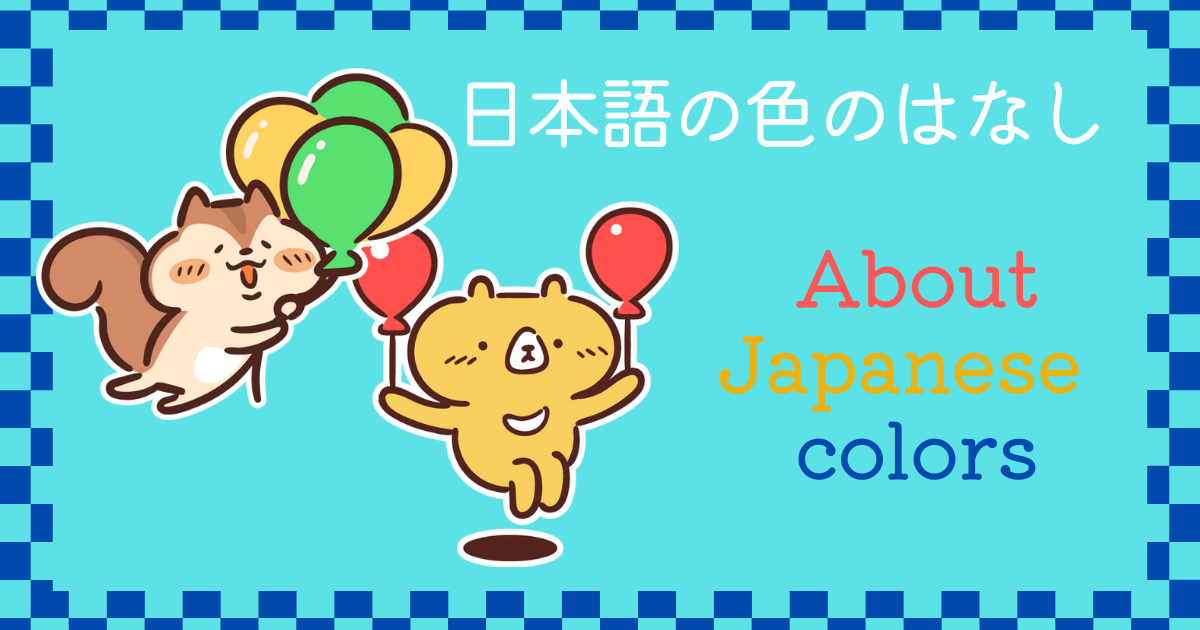
これは赤いりんごです。
This is a red apple.
グリーンはなんていうの?
What is green in Japanese?

グリーンは緑です。
Green is Midori.

これはみどりいりんごです。
This is Midori-i apple.

待って、待って‼
Hold on!!
青い、赤い、黄色い?緑…?
Ao-i, Aka-i, Kiiro-i? Midori…?
色を使う基本的なルール
色を使った表現の練習をしようとしたら末尾が「い」になったり「の」になったりして混乱してしまったということがあるのではないでしょうか?色を表現する基本的なルールはこれ↓ですね。
「○○い」(イ形容詞)として使える色は4色
赤、青、黒、白
「○○色い」(イ形容詞)として使える色は2色
黄色、茶色
それ以外の色は形容詞として使用不可、「○○の」(名詞)という形をとります。
◆イ形容詞・名詞として使用可な色
青・赤・白・黒(4色のみ)
青い空、赤い頬(形容詞)
白のTシャツ、黒のズボン(名詞)
◆イ形容詞・名詞として使用可能な色
※名称+色の形をとる
黄・茶(2色のみ)
黄色い花、茶色い靴(形容詞)
黄色の紙、茶色の髪(名詞)
◆名詞としてのみ使用可能な色
上記6色以外 (緑、紫、ピンク、橙など)
緑の本、紫の箱(名詞)
ではこの違いはどこから来るのでしょうか?
The basic rule of color
Have you ever been confused when using color in Japanese sentences? Some colors can be used as adjectives ending in “○○い”, while some of them can be used only as nouns ending in “○○の”. Here is the basic rule for describing color↓
red, blue, black, white
They can be i-adjective 「○○い」
yellow, brown
They can be i-adjective 「○○色い」
Other colors can’t be adjective, only noun 「〇〇の」
◆Usable for i-adjective and noun
RED, BLUE, BLACK, WHITE (only 4)
Aoi sora, Akai hoho (i-adjective)
Shiro no T-shirt, Kuro no zubon (noun)
◆Usable for i- adjective and noun
※ color name + iro
YELLOW, BROWN (only 2)
Kiiroi hana, Chairoi kutsu (i-adjective)
Kiiro no kami, Chairo no kami (noun)
◆ Usable for only noun
Others (GREEN, PURPLE, PINK, ORANGE… )
Midori no hon, Murasaki no hako (noun)
So where does this difference come from?
日本古来の色は4つ
日本に昔からある”色”は赤、青、黒、白の四つだと考えられています。そしてその色の概念は現在のものとは少し違います。それぞれの色の語源をたどると
赤…明し
黒…暗し
青…淡し(薄い)
白…著し(はっきりしている、濃い)
という言葉からきていると考えられています。
つまり、赤い、青い、という色ではなく、明暗、濃淡を指して使われていたようです。形容詞が語源になっているんですね。
それを考えると、日本語で茶色の毛を赤毛、緑の竹を青竹と、色と実物が合わない表現をしていることにも納得でしょう。
4 Traditional Japanese colors
It is thought that Japan’s traditional colors are blue, red, white, and black. The concepts of these colors differ slightly from modern ones. Tracing the etymologies of each color:
Aka (red)… Akashi (bright)
Kuro (black)… Kurashi (dark)
Ao (blue)… Awashi (pale, light)
Shiro (white)… Shiroshi (clear, deep)
In other words, they were used not to mean red or blue, but to indicate lightness/darkness and intensity/pallor. The origins are adjectives.
Considering this, it makes sense why Japanese use expressions like “red hair” for brown hair or “blue bamboo” for green bamboo—descriptions of colors that don’t match the actual objects.
色はどのように表していた?
日本の基本色が形容詞を語源としていたとわかったところで、では、色はどのように表現していたのでしょう?
日本の伝統色ってどんなものがあるでしょうか?山吹色、桃色、藍色、灰色…色という漢字の前に植物やものの名前が来ています。私たちが思う「色」を表現するときはその色を持つ者の名前を借りて表現していました。黄色も諸説ありますが木や金から、紫も植物からきているそうです。名詞由来の言葉なんですね。
How did they describe hue?
Now, we know Japan’s basic colors originated from adjectives, but how were colors actually expressed?
Let’s look at traditional Japanese colors: Yamabuki(yellow tree flower) iro , Momo(peach) iro, Ai(paint plant) iro , Hai(ash) iro … Notice the names of plants or objects preceding 色 “color.” When describing what we think of as “color,” they borrowed the names of things possessing that hue. Yellow also has various theories, but it seems to come from wood or gold, and purple also from plants. These are noun-derived words.
結論:使うときは6つだけ形容詞
とりあえず文法的には赤、青、黒、白、黄色、茶色の6色だけイ形容詞として使えると覚えておきましょう。
しかし色の背景を調べていくと、昔の日本人の持っていた感覚や、その色を使ってどんな情景を表現したかったのか、というところにつながってきます。昔の歌の理解も深まります。昔古文の授業で習った歌も意味を勘違いしていたかも…そんな面白さがあると、文法的には煩わしくても、日本語の奥深さに敬意を払わずにはいられなくなります。
Only 6 adjective colors
For now, just remember that grammatically, only the six colors red, blue, black, white, yellow, and brown can be used as i-adjectives.
But delving into the background of colors, it connects to the sensibilities of ancient Japanese people and what scenes they sought to express using those colors. It also deepens our understanding of old poems. Maybe I misunderstood the meaning of poems I learned in classical Japanese class long ago… With such fascinating aspects, even if the grammar is troublesome, I cannot help but feel respect for the profound depth of the Japanese language.




コメント